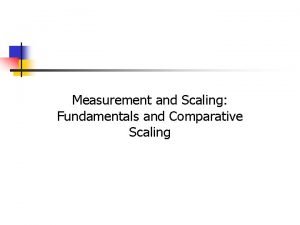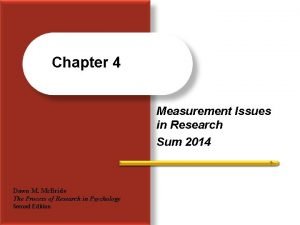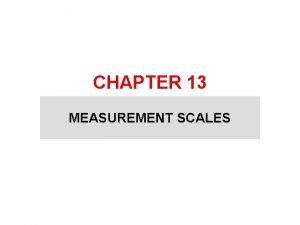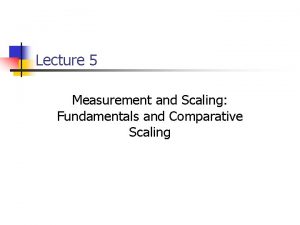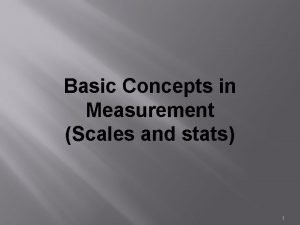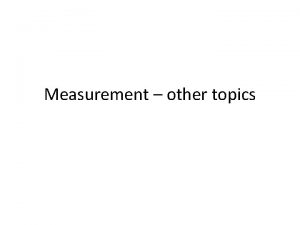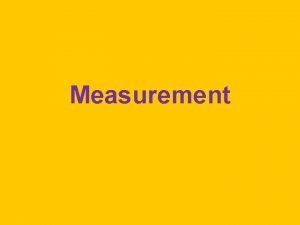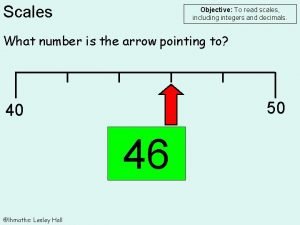Scales of Measurement n n n The scales













- Slides: 13

Scales of Measurement n n n The scales of measurement describe the nature/properties of data The scale of measurement affects the selection of the test statistic The are four scales of measurement: 1. Nominal 2. Ordinal 3. Interval 4. Ratio

Scales of Measurement: Nominal n 1. 2. 3. Characteristics of Nominal Data: Assigns names to variables based on a particular attribute Divides data into discrete categories No quantitative meaning

Scales of Measurement: Nominal n 1. Example: Gender as a variable Names assigned to variables based on particular attribute -Male or female 2. Divides data into discrete categories -Male or female (not both) 3. No quantitative meaning -Males cannot be quantified as “more or less” than girls

Scales of Measurement: Ordinal n 1. 2. Characteristics of Ordinal Data: Has quantifiable meaning Intervals between values not assumed to be equal

Scales of Measurement: Ordinal Example: Likert Scales n UNI Teacher Evaluations: n “Does the instructor show interest. . . ” n ¨ Never ¨ Seldom ¨ Frequently ¨ Always

Scales of Measurement: Ordinal n 1. Example: Likert Scales Has quantifiable meaning -”Never” is less than “seldom” -Values can be rank ordered 2. Intervals between values not assumed to be equal ? Never ? Seldom Frequently Always

Scales of Measurement: Ordinal n Other examples: ¨ Small, medium, large sizes ¨ Low, medium, high performance

Scales of Measurement: Interval n 1. 2. 3. 4. 5. Characteristics of Interval Data: Has quantifiable meaning Intervals between values are assumed to be equal Zero point does not assume the absence of a value Values do not originate from zero Values cannot be expressed as multiples or fractions

Scales of Measurement: Interval n 1. Example: Temperature (Fahrenheit or Celcius) Has quantifiable meaning -10 C° is less than 20 C° 2. Intervals between values are assumed to be equal -The difference between 5 and 10 C° = difference between 15 and 20 C° 3. Zero point does not assume the absence of a value -0 C° does not mean absence of temperature 4. Values do not originate from zero -0 C° is arbitrary based on freezing point 5. Values cannot be expressed as multiples or fractions -10 C° is not twice as cold as 5 C°

Scales of Measurement: Ratio n 1. 2. 3. 4. 5. Characteristics: Has quantifiable meaning Intervals between values are assumed to be equal Zero point assumes the absence of a value Values originate from zero Values can be expressed as multiples or fractions

Scales of Measurement: Ratio n 1. 2. 3. 4. 5. Example: Length Has quantifiable meaning Intervals between values are assumed to be equal Zero point assumes the absence of a value Values originate from zero Values can be expressed as multiples or fractions

Scales of Measurement How do the scales of measurement affect the selection of the test statistic? n Bottom Line: n ¨ Nominal and ordinal data Nonparametric ¨ Interval and ratio data Parametric

Scales of Measurement n Parametric statistics: ¨ Definition: Statistical techniques designed for use when the data have certain specific characteristics in regards to: n n Scale of measurement: Interval or ratio Distribution: Normal ¨ More n powerful Nonparametric statistics: ¨ Definition: Statistical techniques designed to be used when the data are: n n Scale of measurement: Nominal or ordinal or Distribution: Nonnormal
 Measurement marketing research
Measurement marketing research Types of measurement scales
Types of measurement scales Comparative scaling techniques
Comparative scaling techniques 4 measurement scales
4 measurement scales Stapel scale
Stapel scale Marketing measurement scales
Marketing measurement scales Measurement and scaling
Measurement and scaling Measurement scales in research
Measurement scales in research What are the 4 measurement scales?
What are the 4 measurement scales? Types of scales in educational measurement
Types of scales in educational measurement Primary scales of measurement in marketing research
Primary scales of measurement in marketing research 4 scales of measurement
4 scales of measurement 4 measurement scales
4 measurement scales Số nguyên tố là
Số nguyên tố là


